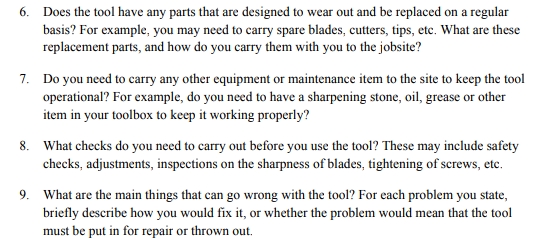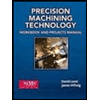6. Does the tool have any parts that are designed to wear out and be replaced on a regular basis? For example, you may need to carry spare blades, cutters, tips, etc. What are these replacement parts, and how do you carry them with you to the jobsite? 7. Do you need to carry any other equipment or maintenance item to the site to keep the tool operational? For example, do you need to have a sharpening stone, oil, grease or other item in your toolbox to keep it working properly? 8. What checks do you need to carry out before you use the tool? These may include safety checks, adjustments, inspections on the sharpness of blades, tightening of screws, etc. 9. What are the main things that can go wrong with the tool? For each problem you state, briefly describe how you would fix it, or whether the problem would mean that the tool must be put in for repair or thrown out.
6. Does the tool have any parts that are designed to wear out and be replaced on a regular basis? For example, you may need to carry spare blades, cutters, tips, etc. What are these replacement parts, and how do you carry them with you to the jobsite? 7. Do you need to carry any other equipment or maintenance item to the site to keep the tool operational? For example, do you need to have a sharpening stone, oil, grease or other item in your toolbox to keep it working properly? 8. What checks do you need to carry out before you use the tool? These may include safety checks, adjustments, inspections on the sharpness of blades, tightening of screws, etc. 9. What are the main things that can go wrong with the tool? For each problem you state, briefly describe how you would fix it, or whether the problem would mean that the tool must be put in for repair or thrown out.
Precision Machining Technology (MindTap Course List)
2nd Edition
ISBN:9781285444543
Author:Peter J. Hoffman, Eric S. Hopewell, Brian Janes
Publisher:Peter J. Hoffman, Eric S. Hopewell, Brian Janes
Chapter1: Introduction To Machining
Section1.2: Careers In Machining
Problem 9RQ: What occupation requires knowledge of several different types of systems in order to troubleshoot...
Related questions
Question
the tool is SCREWDRIVER

Transcribed Image Text:6. Does the tool have any parts that are designed to wear out and be replaced on a regular
basis? For example, you may need to carry spare blades, cutters, tips, etc. What are these
replacement parts, and how do you carry them with you to the jobsite?
7. Do you need to carry any other equipment or maintenance item to the site to keep the tool
operational? For example, do you need to have a sharpening stone, oil, grease or other
item in your toolbox to keep it working properly?
8. What checks do you need to carry out before you use the tool? These may include safety
checks, adjustments, inspections on the sharpness of blades, tightening of screws, etc.
9. What are the main things that can go wrong with the tool? For each problem you state,
briefly describe how you would fix it, or whether the problem would mean that the tool
must be put in for repair or thrown out.
Expert Solution
This question has been solved!
Explore an expertly crafted, step-by-step solution for a thorough understanding of key concepts.
This is a popular solution!
Trending now
This is a popular solution!
Step by step
Solved in 2 steps

Recommended textbooks for you

Precision Machining Technology (MindTap Course Li…
Mechanical Engineering
ISBN:
9781285444543
Author:
Peter J. Hoffman, Eric S. Hopewell, Brian Janes
Publisher:
Cengage Learning

Welding: Principles and Applications (MindTap Cou…
Mechanical Engineering
ISBN:
9781305494695
Author:
Larry Jeffus
Publisher:
Cengage Learning

Precision Machining Technology (MindTap Course Li…
Mechanical Engineering
ISBN:
9781285444543
Author:
Peter J. Hoffman, Eric S. Hopewell, Brian Janes
Publisher:
Cengage Learning

Welding: Principles and Applications (MindTap Cou…
Mechanical Engineering
ISBN:
9781305494695
Author:
Larry Jeffus
Publisher:
Cengage Learning